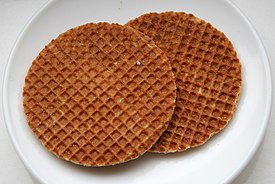Stroopwafel

A stroopwafel () (English translation: syrup waffle or treacle waffle) is a waffle made from two thin layers of baked batter with a caramel-like syrup filling in the middle.[1][2] They were first made in Gouda in the Netherlands, in 1784. Large versions are sold in the streets as a snack.
Ingredients


The stiff batter for the waffles is made from flour, butter, brown sugar, yeast, milk, and eggs. Medium sized balls of batter are put on the waffle iron. When the waffle is baked, and while it is still warm, it is cut into two halves. The warm filling, made from syrup, brown sugar, butter, and cinnamon, is spread in between the waffle halves, which glues them together.[1]
History
The stroopwafel originates from Gouda in the Netherlands. It was first made during the late 18th century[3] or early 19th century[1] by a baker using leftovers from the bakery, such as crumbs, which were sweetened with syrup. One story ascribes the invention of the stroopwafel to the baker Gerard Kamphuisen, which would date the first stroopwafels somewhere between 1810, the year when he opened his bakery, and 1840, the year of the oldest known recipe for syrup waffles.[1] In the 19th century, there were around 100 syrup waffle bakers in Gouda, which was the only city in which they were made until 1870. After 1870 they were also made at parties and in markets outside the city of Gouda. In the 20th century factories started to make stroopwafels. In 1960 there were seventeen factories in Gouda alone, of which four are currently still open.[1]
Trivia
This article contains a list of miscellaneous information. (July 2010) |
- A band in the Netherlands, Amazing Stroopwafels, was named after the Dutch delicacy.
References
- ^ a b c d e Stroopwafels. Een traditionele Goudse lekkernij. Gouda-Online.nl. Retrieved on 2008-01-02. Template:Nl icon
- ^ Stroopwafel. Van Dale Taalweb. Retrieved on 2008-01-02. Template:Nl icon
- ^ History & recipe. Stroopwafelshop.com. Retrieved on 2007-01-03.
External links
- How stroopwafels are made. (video), schepsbakeries.com
- How to Eat a Stroopwafel (video), rikomatic.com
- Dutch Stroopwafels (recipe), dianasdesserts.com
- Association of Stroopwafel Addicts at Meta-Wiki
